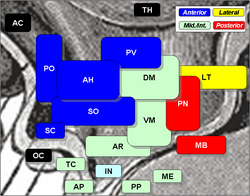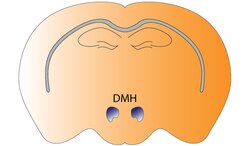Dorsomedial hypothalamic nucleus
| Dorsomedial hypothalamic nucleus | |
|---|---|
 Dorsomedial nucleus is 'DM', at center, in green. | |
 The dorsomedial hypothalamus of the mouse brain | |
| Details | |
| Identifiers | |
| Latin | nucleus dorsomedialis areae hypothalamicae intermediae |
| MeSH | D004302 |
| NeuroNames | 397 |
| NeuroLex ID | birnlex_1558 |
| TA98 | A14.1.08.917 A14.1.08.922 |
| TA2 | 5728 |
| FMA | 62331 |
| Anatomical terms of neuroanatomy | |
The dorsomedial hypothalamic nucleus is a nucleus of the hypothalamus. It is involved in feeding, drinking, body-weight regulation and circadian activity.[1] More specifically, it is a necessary component for the expression of numerous behavioral and physiological circadian rhythms. The dorsomedial hypothalamic nucleus receives information from neurons and humors involved in feeding regulation, body weight and energy consumption, and then passes this information on to brain regions involved in sleep and wakefulness regulation, body temperature and corticosteroid secretion.[2]
Function
The dorsomedial hypothalamic nucleus (DMH) receives its circadian information from the
Clinical significance
Damage
It was found in the study done by Gooley et al. that lesions in DMH neurons in rats prevented food entrainment of wakefulness, locomotor activity, and core body temperature. This further verifies its role in oscillation between feeding and circadian rhythm.[3] Lesions in the DMH of rats also caused a weakened level of response to the feeding-stimulant insulin.[6]
